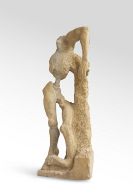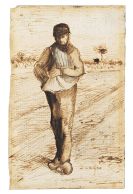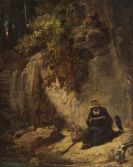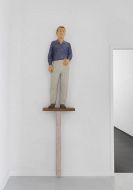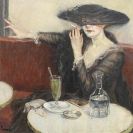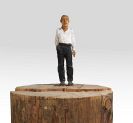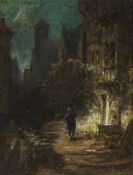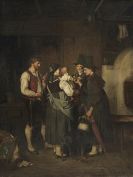
Jozef Israëls
Groningen
1824 -
Den Haag
1911
The parents of the Dutch painter and graphic artist Jozef Israëls wanted him to become a Rabbi. A religious upbringing and the Talmudic studies begun at an early age profoundly shaped his intellectual and spiritual development. While still very young, Jozef Israëls was given private lessons by J.J.G. van Wicheren and C.B. Buys at the Minerva Drawing Academy in Groningen.
In 1840 Jozef Israëls embarked on an apprenticeship under the Amsterdam portraitist and history painter Jan Adam Krusemann while also attending the Academy and working under Jan Willem Pienemann and the sculptor Royer. Ary Scheffer, Decamps, Raphael and Rembrandt were the artists Israëls particularly admired. In 1845 Israëls and his fellow pupil J. van Koningsveld went to Paris, where Jozef Israëls learned how to execute history paintings in the Romantic manner at the Atelier Picot while studying at the Académie des Beaux-Arts.
After two years in Paris, Jozef Israëls returned to Amsterdam and entered a competition mounted by the Academy. Although he was not awarded a prize, he was singled out by art critics for praise. Jozef Israëls' breakthrough came with the paintings "Meditation" (1850) and "Adagio con espressione" (1851). Israëls was one of the few Dutch artists of his day to satisfy the prevailing taste for enthralling narrative in the form of "history paintings in the grand manner".
Jozef Israëls visited Düsseldorf and the landscape painter J.W. Bilders in Oosterbek. On returning to Holland, Israëls devoted himself to Dutch history, which he rendered with historical accuracy while strongly emphasizing the individual psychological aspect. In 1853 Israëls again went to Paris and, as he had done in 1846, visited Barbizon. For health reasons he stayed at Zandevoort, a seaside resort, in 1855. There he did a lot of sketching and outlined enough compositions to last him for the rest of his active career and make him famous. From then on Jozef Israël's motifs of choice were fishermen and farmhands.
In 1856 Jozef Israels went to Katwijk and, in 1862, to London. He settled in The Hague in 1871, remaining there until his death in 1911. Until 1885 he also taught his son, Isaac Israëls, who would later establish a well-earned reputation as an "Amsterdam Impressionist".
Jozef Israëls was the most important Dutch painter of the 19th century, one of the leading exponents of the Hague school and the most popular artist of his day in the Netherlands. He was on the committee that organised the first Venice Biennale for 1895, which, however, took place two years later. Jozef Israëls' works hang in the world's great museums, including the Rijksmuseum in Amsterdam, the Metropolitan Museum in New York and the National Gallery in London.
Would you like to sell a work by Jozef Israëls?
Infos for seller
